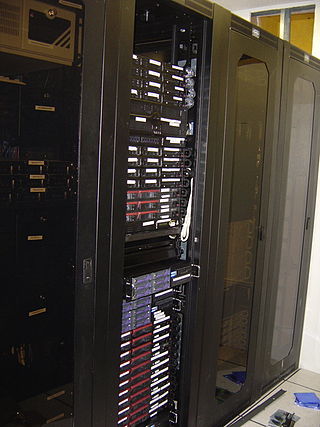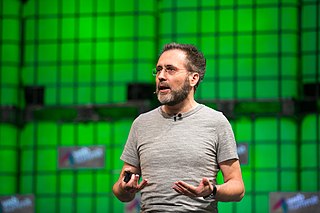
A server farm or server cluster is a collection of computer servers, usually maintained by an organization to supply server functionality far beyond the capability of a single machine. They often consist of thousands of computers which require a large amount of power to run and to keep cool. At the optimum performance level, a server farm has enormous financial and environmental costs. They often include backup servers that can take over the functions of primary servers that may fail. Server farms are typically collocated with the network switches and/or routers that enable communication between different parts of the cluster and the cluster's users. Server "farmers" typically mount computers, routers, power supplies and related electronics on 19-inch racks in a server room or data center.

A data center or data centre is a building, a dedicated space within a building, or a group of buildings used to house computer systems and associated components, such as telecommunications and storage systems.
Green computing, green IT, or ICT sustainability, is the study and practice of environmentally sustainable computing or IT.

Urs Hölzle is a Swiss software engineer and technology executive. As Google's eighth employee and its first VP of Engineering, he has shaped much of Google's development processes and infrastructure, as well as its engineering culture. His most notable contributions include leading the development of fundamental cloud infrastructure such as energy-efficient data centers, distributed compute and storage systems, and software-defined networking. Until July 2023, he was the Senior Vice President of Technical Infrastructure and Google Fellow at Google. In July 2023, he transitioned to being a Google Fellow only.
The Climate Savers Computing Initiative was a nonprofit group of consumers, businesses and conservation organizations dedicated to promoting smart technologies that improve power efficiency and reduce energy consumption of computers. Formed in 2007, it was based in Portland, Oregon. In July 2012, Climate Savers Computing Initiative combined with The Green Grid and its programs continue within that organization.
In computing, performance per watt is a measure of the energy efficiency of a particular computer architecture or computer hardware. Literally, it measures the rate of computation that can be delivered by a computer for every watt of power consumed. This rate is typically measured by performance on the LINPACK benchmark when trying to compare between computing systems: an example using this is the Green500 list of supercomputers. Performance per watt has been suggested to be a more sustainable measure of computing than Moore's Law.
The Green Grid is a nonprofit, industry consortium of end-users, policy-makers, technology providers, facility architects, and utility companies collaborating to improve the resource efficiency of data centers.
Miscellaneous electric loads (MELs) in buildings are electric loads resulting from a multitude of devices (electronic and other) excluding main systems for space heating, cooling, water heating, or lighting. MELs are produced by hard-wired and “plug-in” electrical devices that draw power, including office equipment such as desktop computers and monitors, mobile electronics (laptops, tablets, mobile phones, and their charging units), printers, fans, task lighting, and home equipment such as home entertainment centers, kitchen electronics (microwaves, toaster ovens, cooking accessories), bath items (hair dryers, lighted mirrors, and electric hot tubs), and other devices such as security systems and ceiling fans. MELs are gaining greater importance in energy management as personal electronics proliferate and become standard across demographic groups. MELs demand has been rising as a percentage of total energy end-use and is expected to continue rising.
Data center infrastructure efficiency (DCIE), is a performance improvement metric used to calculate the energy efficiency of a data center. DCIE is the percentage value derived, by dividing information technology equipment power by total facility power.
IT energy management or Green IT is the analysis and management of energy demand within the Information Technology department in any organization. IT energy demand accounts for approximately 2% of global CO2 emissions, approximately the same level as aviation, and represents over 10% of all the global energy consumption. IT can account for 25% of a modern office building's energy cost.
An Energy Rebate Program, or Energy Credit Incentive Program, provides a cash rebate program for customers planning to install new, energy efficient information technology (IT) equipment or cooling systems. These programs push companies to construct more energy efficient data centers, or to consolidate compute, storage and networking resources via virtualization technologies.
Green Power Usage Effectiveness (GPUE) is a proposed measurement of both how much sustainable energy a computer data center uses, its carbon footprint per usable kilowatt hour (kWh) and it uses its power; specifically, how much of the power is actually used by the computing equipment. It is an addition to the power usage effectiveness (PUE) definition and was first proposed by Greenqloud.

The HP Performance Optimized Datacenter (POD) is a range of three modular data centers manufactured by HP.
NABERS, the National Australian Built Environment Rating System, is an initiative by the government of Australia to measure and compare the environmental performance of Australian buildings and tenancies. There are NABERS rating tools for commercial office buildings to measure greenhouse gas emissions, energy efficiency, water efficiency, waste efficiency and indoor environment quality. There are also energy/greenhouse and water rating tools for hotels, shopping centres and data centres.
Energy Logic is a vendor-neutral approach to achieving energy efficiency in data centers. Developed and initially released in 2007, the Energy Logic efficiency model suggests ten holistic actions – encompassing IT equipment as well as traditional data center infrastructure – guided by the principles dictated by the "Cascade Effect."
Water Usage Effectiveness (WUE) is a sustainability metric created by The Green Grid in 2011 to attempt to measure the amount of water used by datacenters to cool their IT assets. To calculate simple WUE, a data center manager divides the annual site water usage in liters by the IT equipment energy usage in kilowatt hours (Kwh). Water usage includes water used for cooling, regulating humidity and producing electricity on-site. More complex WUE calculations are available from The Green Grid website.

Immersion cooling is an IT cooling practice by which complete servers are immersed in a dielectric, electrically non-conductive fluid that has significantly higher thermal conductivity than air. Heat is removed from a system by putting the coolant in direct contact with hot components, and circulating the heated liquid through heat exchangers. This practice is highly effective because liquid coolants can absorb more heat from the system, and are more easily circulated through the system, than air. Immersion cooling has many benefits, including but not limited to: sustainability, performance, reliability and cost

Super Micro Computer, Inc., dba Supermicro, is an American information technology company based in San Jose, California. It has manufacturing operations in the Silicon Valley, the Netherlands and at its Science and Technology Park in Taiwan. Founded on November 1, 1993, Supermicro is one of the largest producers of high-performance and high-efficiency servers. It also provides server management software, and storage systems for various markets, including enterprise data centers, cloud computing, artificial intelligence, 5G and edge computing.
The Zettabyte Era or Zettabyte Zone is a period of human and computer science history that started in the mid-2010s. The precise starting date depends on whether it is defined as when the global IP traffic first exceeded one zettabyte, which happened in 2016, or when the amount of digital data in the world first exceeded a zettabyte, which happened in 2012. A zettabyte is a multiple of the unit byte that measures digital storage, and it is equivalent to 1,000,000,000,000,000,000,000 (1021) bytes.

A green data center, or sustainable data center, is a service facility which utilizes energy-efficient technologies. They do not contain obsolete systems, and take advantage of newer, more efficient technologies.







